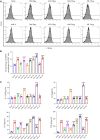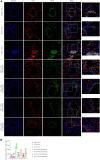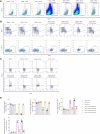Immunosuppressive Ability of Trichinella spiralis Adults Can Ameliorate Type 2 Inflammation in a Murine Allergy Model
- PMID: 38016013
- PMCID: PMC11011206
- DOI: 10.1093/infdis/jiad518
Immunosuppressive Ability of Trichinella spiralis Adults Can Ameliorate Type 2 Inflammation in a Murine Allergy Model
Abstract
Background: There is an increase in the global incidence of allergies. The hygiene hypothesis and the old friend hypothesis reveal that helminths are associated with the prevalence of allergic diseases. The therapeutic potential of Trichinella spiralis is recognized; however, the stage at which it exerts its immunomodulatory effect is unclear.
Methods: We evaluated the differentiation of bone marrow-derived macrophages stimulated with T spiralis excretory-secretory products. Based on an ovalbumin-induced murine model, T spiralis was introduced during 3 allergy phases. Cytokine levels and immune cell subsets in the lung, spleen, and peritoneal cavity were assessed.
Results: We found that T spiralis infection reduced lung inflammation, increased anti-inflammatory cytokines, and decreased Th2 cytokines and alarms. Recruitment of eosinophils, CD11b+ dendritic cells, and interstitial macrophages to the lung was significantly suppressed, whereas Treg cells and alternatively activated macrophages increased in T spiralis infection groups vs the ovalbumin group. Notably, when T spiralis was infected prior to ovalbumin challenge, intestinal adults promoted proportions of CD103+ dendritic cells and alveolar macrophages.
Conclusions: T spiralis strongly suppressed type 2 inflammation, and adults maintained lung immune homeostasis.
Keywords: Trichinella spiralis; allergic asthma; alternatively activated macrophages; immunosuppressive response; ovalbumin.
© The Author(s) 2023. Published by Oxford University Press on behalf of Infectious Diseases Society of America.
Conflict of interest statement
Potential conflicts of interest. All authors: No reported conflicts. All authors have submitted the ICMJE Form for Disclosure of Potential Conflicts of Interest. Conflicts that the editors consider relevant to the content of the manuscript have been disclosed.
Figures








Similar articles
-
Therapeutic potentials of Trichinella spiralis in immune disorders: From allergy to autoimmunity.Parasites Hosts Dis. 2025 May;63(2):123-134. doi: 10.3347/PHD.24086. Epub 2025 May 26. Parasites Hosts Dis. 2025. PMID: 40452274 Free PMC article. Review.
-
Adoptive transfer of Trichinella spiralis-activated macrophages can ameliorate both Th1- and Th2-activated inflammation in murine models.Sci Rep. 2019 Apr 25;9(1):6547. doi: 10.1038/s41598-019-43057-1. Sci Rep. 2019. PMID: 31024043 Free PMC article.
-
Preventive and therapeutic effects of Trichinella spiralis adult extracts on allergic inflammation in an experimental asthma mouse model.Parasit Vectors. 2019 Jun 28;12(1):326. doi: 10.1186/s13071-019-3561-1. Parasit Vectors. 2019. PMID: 31253164 Free PMC article.
-
Protection against allergic airway inflammation during the chronic and acute phases of Trichinella spiralis infection.Clin Exp Allergy. 2013 Jan;43(1):103-15. doi: 10.1111/cea.12042. Clin Exp Allergy. 2013. PMID: 23278885
-
Trichinella spiralis: inflammation modulator.J Helminthol. 2020 Sep 21;94:e193. doi: 10.1017/S0022149X20000802. J Helminthol. 2020. PMID: 32951619 Review.
Cited by
-
The unique activity of the bone morphogenetic protein TGH4 affects the embryonic development of Trichinella spiralis and the establishment of vaccine protection.Vet Res. 2025 Feb 7;56(1):31. doi: 10.1186/s13567-025-01473-4. Vet Res. 2025. PMID: 39915830 Free PMC article.
-
Trichinella spiralis-derived extracellular vesicles induce regulatory T cells and reduce airway allergy in mice.Front Immunol. 2025 Jul 11;16:1637569. doi: 10.3389/fimmu.2025.1637569. eCollection 2025. Front Immunol. 2025. PMID: 40718495 Free PMC article.
-
Therapeutic potentials of Trichinella spiralis in immune disorders: From allergy to autoimmunity.Parasites Hosts Dis. 2025 May;63(2):123-134. doi: 10.3347/PHD.24086. Epub 2025 May 26. Parasites Hosts Dis. 2025. PMID: 40452274 Free PMC article. Review.
References
-
- Akdis CA. Does the epithelial barrier hypothesis explain the increase in allergy, autoimmunity and other chronic conditions? Nat Rev Immunol 2021; 21:739–51. - PubMed
MeSH terms
Substances
Grants and funding
LinkOut - more resources
Full Text Sources
Medical
Research Materials

